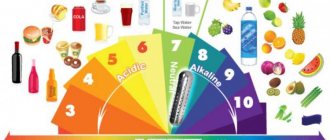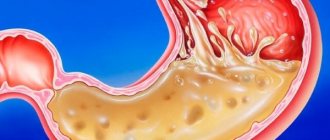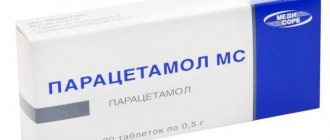In the stomach of a healthy person, up to 2-2.5 liters of gastric juice are secreted per day, which consists of water, pepsinogen and hydrochloric acid. Despite the fact that the proportion of hydrochloric acid in gastric juice does not exceed 0.5%, the acidity of gastric juice is extremely high, which ensures pronounced proteolytic and bactericidal properties of gastric secretions, on the one hand, and its extremely aggressive effect on the mucous membrane of the esophagus, stomach and duodenum intestines (DPK) - on the other.
There is a group of diseases united by the general term “acid-dependent diseases” (ADD), the pathogenesis of which is based on a change in the secretion of hydrochloric acid in gastric juice or an increase in the duration of exposure of aggressive gastric secretions on the mucous membrane. In such cases, assessment of acid production and exposure allows us to correctly establish a diagnosis, carry out a differential diagnosis, and select an adequate treatment regimen.
The acidity of gastric juice is determined by the value of the hydrogen index (pH) using a method called “pH-metry”. The method is based on measuring the concentration of H+ ions directly in the gastrointestinal tract (GIT) using a pH probe and a corresponding recording device (acidogastrometer), followed by calculation of pH, which is the negative decimal logarithm of the concentration of H+ ions.
Currently, to evaluate the results of long-term pH-metry of the stomach and esophagus, various indicators are used that reflect the acidity of gastric juice: pH calculated from the average concentration of H+ ions, arithmetic mean pH, root mean square pH, median pH, percentage of time with intraesophageal pH <4.0, acidity index, generalized DeMeester index, etc. [1-4].
In practice, when calculating the average pH level of a daily pH gram, it is often not taken into account that the pH indicator is the negative decimal logarithm of the concentration of H+ ions. The dimensionless pH is a negative degree of acidity. With an increase in pH from 2 to 3, i.e. by 1 unit, the acidity of 0.01 mol/l decreases to 0.001 mol/l, i.e. 10 times. That is why the average (arithmetic mean) pH value (the ratio of the sum of all pH values of the daily pH-gram to their number) of the daily pH-gram cannot be used as an indicator of the acidity of gastric juice.
The results of the analysis of pH grams obtained by calculating the arithmetic average pH values do not reflect the true level of acidity of gastric juice during the day and cause difficulties for practitioners when interpreting the conclusions of pH grams. This is due to the frequent discrepancy between the average daily gastric pH (most often showing high values in connection with episodes of duodenogastric reflux (DGR) and food intake), indicating the hypoacidity of gastric secretions, with episodes with extremely low intragastric pH (pH <1.6, hyperacidity) in the same patient.
For example, if a very short-term discharge of alkaline contents of the duodenum with a pH of 7.1-7.9 into the patient’s stomach during the period of DGR, then the average pH values in the stomach, calculated as the arithmetic average, will be significantly overestimated (average pH 3.1, hypoacidity) , even if most of the time (48.1% of the study time) the secretion of hydrochloric acid in the stomach was preserved (Fig. 1).
Rice. 1. Daily pH-metry of the esophagus and stomach of a 37-year-old patient. An increase in pH in the body of the stomach during the period of DGR and during food intake; the percentage of time with pH <1.6 is 48.1%; the arithmetic average pH per day is 3.1 (hypoacidity); calculated by the average concentration of H+ ions pH 1.4 (hyperacidity). Increased pH level in the body of the stomach during duodenogastric reflux and in the period of food intake; the time with pH <1.6 in percent — 48.1%; the daily mean arithmetic pH level is 3.1 (hypoacidity); the pH level calculated from the average H+-ion concentration is 1.4 (hyperacidity). If we calculate the average daily acidity in the body of the stomach, focusing on the average concentration of H+ ions in the stomach per day, then the pH turns out to be equal to 1.4 (hyperacidity), which reflects the true state of the secretory function of the stomach. Thus, hydrochloric acid is very actively produced in the patient’s stomach, and temporary increases in pH are associated not with hypoacidity, but with episodes of GHD and the buffering effect of food.
This example clearly demonstrates that the use of inadequate acidity indicators can lead to serious diagnostic errors and fatally affect treatment tactics, negating the whole point of daily pH measurements of the esophagus and stomach. Obviously, with the conclusion “hypoacidity,” the doctor will have no reason to prescribe antisecretory therapy to a patient who actually suffers from a disease whose pathogenesis is based on hypersecretion of hydrochloric acid of gastric juice.
The above-described errors in the interpretation of 24-hour gastric pH-metry data lead not only to incorrect treatment tactics for patients, but also to ambiguous results of scientific and clinical studies. Thus, in the work of I.Yu. Kolesnikova and E.K. Lukasheva [5] during an examination of 96 patients with recurrent gastric ulcer (GUD) in the body of the stomach, the average acidity pH value was 3.20±0.14, which corresponds to hypoacidity, while pH values <1.6 in the stomach in this group patients were observed more than 50% of the time of day, which proves hyperacidity.
The results of another work [6] on studying the pH level in the acid-forming zone of the stomach in 187 children aged 9 to 16 years with chronic diseases of the upper digestive tract showed that in the body of the stomach with an average acidity pH of 2.35 (hypoacidity) was also observed acidity pH <1.6 in more than 50% of the study time, which reliably indicates hyperacidity of gastric juice. In the same study [6], in a group of children with erosive and ulcerative lesions of the esophagus, stomach and/or duodenum, the average acidity level in the body of the stomach was 2.27±0.16 (hypoacidity), and the time with hyperacid pH values was <1.6 amounted to 63.2% of the time of the daily pH-gram. The main reason for determining the average daily hypoacidity (pH 2.35±0.06) in this work with the duration of hyperacidity (pH <1.6) in the body of the stomach from 50 to 63% was the use of the arithmetic mean pH value.
To assess the results of daily pH-metry of the esophagus, indicators such as acid exposure in the esophagus (time with pH <4) and the generalized DeMeester index are used [4]. The boundary between physiological and pathological gastroesophageal reflux (GER) is considered to be a DeMeester value of 14.72 (normal is less than 14.72). According to various studies, the limit of pathological exposure of acid in the esophagus is considered to be time with pH <4.0, more than 3.5, 4.2, 4.5 and even 6% of the study time [7-11].
According to the latest data, it is the assessment of acid exposure in the esophagus (5 cm above the upper limit of the lower esophageal sphincter; LES) that has greater diagnostic value for verifying the diagnosis of gastroesophageal reflux disease (GERD) than the DeMeester indicator [11]. It is important that when calculating these indicators, as well as when calculating the average daily pH in the stomach, the concentration of H+ ions in all gastroesophageal refluxes with pH <4.0 is not taken into account.
It is noteworthy that the indicator “acidity index”, proposed in 2004 by R. Tutuian, D. Castell [3] to improve the accuracy of assessing the level of acidity (pH) of the stomach, determined by the formula below, also does not take into account the logarithmic dependence of pH on acidity, t i.e. from the concentration of H+ ions: (% time pH <4 – % time pH <3) × 1 + (% time pH <3 – % time pH <2) × 10 + (% time pH <2 – % time pH <1) × 100 + (% time pH <1 – % time pH <0.8) × 1000.
According to R. Tutuian, D. Castell [3], the acidity index does not distinguish between pH levels in each of the four calculation intervals. Thus, in the pH range from 2.01 to 2.99, the concentration of H+ ions for pH 2.01 is approximately 10 times greater than the concentration of H+ ions than at pH 2.99, and when calculating the acidity index, it is used for all values of the interval 2, 01—2.99 same coefficient 10.
Considering the lack of adequate indicators for assessing the acidity of gastric juice and indicators assessing the damaging effect of reflux on the mucous membrane of the esophagus, employees of the Istok-System Research and Production Enterprise developed new indicators for the analysis of daily pH measurements.
As indicated in the previously published work of G.A. Yakovleva et al. [2], the most accurate and correct criteria for assessing acidity in the stomach and esophagus, determined by the method of daily pH-metry, are the values of the average daily pH, calculated from the average concentration of H+ ions, as well as the average concentration of H+ ions in the refluxate of gastric contents in the esophagus.
1.General information
Every adult has heard about such a functional indicator of the digestive system as acidity. And not only adults: a school chemistry course includes information about the pH value, acid-base balance, as well as litmus paper and phenolphthalein as indicators of acidity.
The pH value of the gastric environment should normally be significantly shifted to the acidic side: if approximately seven is considered a neutral value, then the pH of gastric juice is 1.5-2.5. This is one of the evolutionary protective measures that, to some extent, prevents the introduction and reproduction of numerous infectious pathogens that enter the body in large quantities with food. In addition, a strongly acidic environment is provided as a normative condition for food processing in such a complex biochemical synthesizer as our digestive (digestive) system.
However, acid has an aggressive and destructive effect not only on pathogenic microorganisms and food products; it can also corrode its own mucous membrane lining the inner surface of the stomach. Therefore, it is necessary, firstly, precise control and constant “adjustment” of the acidity level, and secondly, physicochemical protection of one’s own tissues. The regulatory function is ensured by the fact that the stomach produces, along with hydrochloric acid, special mucus with an alkaline pH reaction, which, as necessary, neutralizes excess acid and acts as a surface protector for the gastric walls.
Any deviations from the natural pH level for the stomach, if they are persistent or chronic, are dangerous. So, low acidity, i.e. рh>5, leads to the development of antacid gastritis and is considered a precancerous condition. Increased acidity in recent decades has become a real scourge of modern man.
Excessive “acidification” of the gastric environment (acidosis, ph
A must read! Help with treatment and hospitalization!
Material and methods
To increase the accuracy of assessing the acidity of gastric juice and optimize the diagnosis of GERD, 30 daily pH-grams of patients with a pathological generalized DeMeester index (>14.72) and 30 pH-grams of healthy volunteers were analyzed, and a method was developed for calculating acid exposure in the esophagus in the pH range of 0, 8–4.0, taking into account coefficients that take into account the acidity (average pH levels) of four pH intervals (table):
Coefficients for pH values in the range from 0.8 to 4.0
- not less than 0.8 - less than 1.0;
- not less than 1.0 - less than 2.0;
- not less than 2.0 - less than 3.0;
- no less than 3.0 - less than 4.0.
For example, in the pH range from no less than 1.0 to less than 2.0 for an average pH level of 1.1, the acidity coefficient is 0.0794 (mol/l) × 100 = 7.94, and for an average pH level of 1.9 the coefficient acidity is 0.0126 (mol/l) × 100 = 1.26 (see table).
The modern GastroScan software package, supplied as part of the devices (Gastroscan-24, Gastroscan-GEM, Gastroscan-IAM), can convert the pH values of the daily pH-gram of the esophagus into the concentration of hydrogen ions H+ and calculate the average pH level from the average concentration of H+ ions in the acidity range from pH ≥0.8 to pH <4.0, and calculate the percentage of time with acidity in the range from pH ≥0.8 to pH <4.
2. Reasons
There are so many possible reasons for a persistent increase in acidity that they are usually divided into two large groups: endogenous and exogenous (internal and external, respectively).
The most common endogenous factors include:
- hereditary predisposition;
- chronic infections and/or presence of parasites;
- persistent hypoxia (lack of oxygen supply to tissues and organs);
- metabolic (metabolic) disorders;
- hypovitaminosis, deficiency of microelements, amino acids, etc.
Main exogenous factors:
- smoking and drinking alcohol, especially strong drinks;
- distortions in the daily diet (infatuation with spicy, fatty, spicy, over-salted, too hot and other dishes that irritate the mucous membranes of the gastrointestinal tract);
- long-term or amateur use of medications without prior consultation and supervision of a gastroenterologist;
- work in some hazardous industries, which involve, in particular, constant contact with nitrates;
- physical inactivity, sedentary lifestyle, haphazard eating with long breaks and a predominance of sandwiches, fast food, sour juices, coffee, carbonated drinks and similar “stomach killers.”
Visit our Gastroenterology page
Accessory organs of the digestive system
The human digestive system could not work so efficiently if auxiliary organs did not participate in this: liver, pancreas, salivary glands.
Salivary glands
They produce saliva, which moistens the bolus of food and ensures its easy sliding down the esophagus. The salivary enzyme amylase starts the process of breaking down carbohydrates.
Pancreas
The pancreas produces a secretion containing the enzymes lipase (breaks down fats), amylase (breaks down carbohydrates) and protease (breaks down proteins). In addition, insulin is synthesized in the pancreas, a hormone through which glucose is absorbed by tissues.
Two more hormones produced in the pancreas are glucagon and somatostatin. Glucagon is an insulin antagonist (acts in the opposite way) and causes an increase in blood glucose concentrations. Somatostatin suppresses the work of other endocrine glands.
Finally, this organ produces a special hormone-like substance - ghrelin, which causes appetite.
Liver and gallbladder
The human liver is an important organ that performs many functions. It neutralizes toxins, neutralizes “spent” hormones, vitamins and biologically active substances, stores glycogen - the most important source of glucose in the body, regulates fat metabolism, and is a blood depot. As a digestive organ, the liver produces bile, which is stored in the gallbladder, and when food enters the intestine, it is released into the lumen of the duodenum. Bile acids, mixing with the food bolus, break down fats and promote their digestion.
3. Symptoms and diagnosis
A classic companion to high acidity is a specific baking, burning sensation in the esophagus, which we call heartburn. Heartburn can be so intense that the attack ends in vomiting. Most often, heartburn is caused by the so-called. reflux, i.e. reverse reflux of stomach contents up the esophagus, which should not happen under any circumstances with normal peristalsis, secretory activity and sphincter function: the walls of the esophagus do not have the same mucous-alkaline protection against acid that the stomach is equipped with.
In addition to heartburn, almost all patients complain of heaviness, abdominal pain of various types (dull, aching, pulling, “twisting”) and with various irradiations. Painful discomfort is usually associated with eating: when the stomach is full, the acid, so to speak, finds a new field of activity, but after 1-2 hours the pain returns.
It should be understood that a violation of the acid-base balance is a guarantee of complex, multifactorial digestive disorders (dyspepsia inevitably develops: constipation, diarrhea, nausea, vomiting, appetite disorders) and, therefore, metabolism. The walls of the stomach and the duodenum closest to it, from constant contact with an aggressive acidic environment, are covered first with superficial erosions, and then with ulcers that corrode the submucosal, deeper and therefore unprotected cell layers. A special “ulcerative type” of a patient suffering from gastroduodenitis or peptic ulcer disease itself is a thin, emaciated person with unhealthy skin and problem hair, a sallow complexion, dull and ever-tired eyes, a sarcastic, doomed mood (though many of them do not consider necessary to make at least some adjustments to your lifestyle). However, if the syndrome of high acidity and the associated erosive gastritis, duodenitis, colitis, peptic ulcer continue to remain, as they say in medicine, untreated, the situation can quickly become life-threatening: massive bleeding can begin at any moment or a perforation of the walls of the stomach or intestines can occur. , which leads to peritonitis, sepsis and other deadly complications.
The diagnostic standard in modern gastroenterology is fibrogastroduodenoscopy (FGDS) - examination of the upper gastrointestinal tract from the inside. For this purpose, today we use not the ever-memorable “hoses” or “rubber tubes”, which served as a nightmare for many generations of patients, but high-tech, thin, flexible and very “smart” endoscopes, interfaced with a computer, equipped with a backlit video camera and the necessary manipulators (which allows “on the spot” to select material for biopsy, deliver the necessary treatment solutions, measure the pH level in various zones, etc.). The discomfort from such a procedure today is, perhaps, more of a psychological nature than physiological: the sensitivity of the pharynx and the gag reflex are suppressed by reliable irrigating anesthetics, and the procedure itself lasts only a few minutes - but the whole “picture” from the upper parts of the esophagus to the internal space of the duodenum is displayed in high resolution, stored on disk and provides invaluable information about the real state of affairs.
If necessary, radiography, tomographic and ultrasound examinations, and a set of laboratory tests are also prescribed.
About our clinic Chistye Prudy metro station Medintercom page!
results
It has been established that when using the average pH, calculated from the average concentration of H+ ions, it is possible to reliably classify the average daily values in the body of the stomach of patients as follows:
— pH ≥1.6 — pH ≤2.0 — normacidity;
— pH ≤1.5 — hyperacidity;
— pH >2.0 — pH ≤6.0 — hypoacidity;
— pH >6.0 — anacidity.
It has been shown that reliable average daily values of acidity of the stomach and esophagus are the average pH values calculated from the average concentration of H+ ions. It is these indicators, combined with the percentage of time with pH <1.6 in the stomach and the percentage of time with pH from 0.8 to 4 in the esophagus, that ensure the correct determination of the time-prevailing levels of actual acidity in the body of the stomach and esophagus, and therefore high accuracy diagnosis and treatment effectiveness of CDZ.
When studying the levels of gastric secretion of hydrochloric acid, the average daily pH calculated from the average concentration of H+ ions should be used.
When studying the acidity of the esophagus (for example, 5 cm above the LES), the average daily pH calculated from the average concentration of H+ ions and the average pH level in the range from 0.8 to 4.0, as well as the percentage of time with a pH from 0.8 to 4.0, should also be used. 4.0, calculated taking into account the average concentrations of H+ ions (mol/l) in four acidity ranges by applying coefficients (see table).
For example, from Fig. 2 is visible
Rice. 2. pH-gram of the body of the stomach of a 37-year-old patient. that hyperacidity (pH <1.6) in the body of the patient’s stomach is observed in 61.9% of the study time; The average daily pH of the stomach body, calculated from the average concentration of H+ ions, is 1.3 (hyperacidity). The arithmetic mean value of the average daily pH of the stomach body was 1.8 (normality). pH values of 1.3 and 1.8 correspond to acidity of 0.0501 and 0.0158 mol/l, i.e., the acidity for pH 1.3, calculated from the average concentration of H+ ions, is greater than the acidity for the arithmetic mean pH of 1.8 in 3 ,2 times.
Clinical examples
Let us consider the acidity indicators used in the diagnosis of CVD using examples.
From the analysis of the results of the pH-gram of the esophagus (5 cm above the LES) of patient I
., 66 years old (Fig. 3)
Rice.
3. pH-gram of the esophagus (sensor No. 3 5 cm above the LES) of patient I., 66 years old. it follows that the generalized DeMeester indicator is 13.80 (norm <14.72); the percentage of time with pH <4.0 is 3.8% (normal <4.5%); the arithmetic mean pH value is 5.7, the median pH is 5.8, which corresponds to the norm for the esophagus (norm pH 6-7). At the same time, the average daily acidity in the esophagus calculated from the average concentration of H+ ions (see Fig. 3) is pH 3.2, which is almost 2 times less than the specified norm for the esophagus.
Now let's calculate the percentage of time with a pH ranging from 0.8 to 4.0 in four intervals. The percentage of time in the range with 0.8≤ pH <1.0 is equal to 0. The percentage of time with acidity in the ranges 1.0≤ pH <2.0; 2.0 ≤ pH<3.0; 3.0≤рН<4.0 were 1.4, 0.9, 1.4%, respectively, the average pH levels in these ranges are 1.4; 2.3; 3.4, and coefficients K1.4, K2.3, K3.4 - respectively 3.98; 0.501; 0.0398 (see table). The percentage of time with pH <4.0, taking into account the actual acidity in the specified intervals is equal to: 1.4% × 3.98 + 0.9% × 0.5 + 1.4% × 0.0398 = 5.57 + 0, 45 + 0.06 = 6.1%. Thus, the percentage of time with pH <4.0 in the esophagus of patient I
. equal to 6.1%, which exceeds the norm (norm <4.5%).
Consequently, the average daily pH of 3.2 (normal pH is 6.0-7.0) and the percentage of time with pH <4.0, calculated taking into account the average concentrations of H+ ions, indicate pathological acidification of the esophagus of patient I
., although the generalized DeMeester score was within normal limits (<14.72).
Let us analyze the results of the daily pH-gram of the esophagus (sensor No. 3 5 cm above the LES) of patient K
., 48 years old (Fig. 4).
Rice. 4. Daily pH-gram of the esophagus (sensor No. 3 5 cm above the LES) of patient K., 48 years old. DeMeester's overall score is 8.82. The percentage of time with pH <4.0, excluding acidity, is 2.5% (normal). The average daily pH in the esophagus, calculated from the average concentration of H+ ions, is 3.1 (normal pH is 6.0-7.0). The percentage of time with pH <4.0, calculated using the average H+ ion concentrations in the four pH ranges indicated, is 8.9% (0.1% × 15.85 + 1.4% × 5.01 + 0.6%
0.0398 ), which clearly indicates pathological acidification of the esophagus of patient K.
4.Treatment
To a certain extent (and only with the agreement of a gastroenterologist!) acidity can be controlled by yourself by drinking, for example, bicarbonate mineral waters. However, self-medication, in particular, “quenching acid with soda” still practiced by the population, is in itself dangerous, since a violent acid-base reaction with the formation of salt and water occurs in vivo in a somewhat more complex manner and differs from school chemical experiments in vitro.
The therapeutic regimen, of course, is selected on a strictly individual basis, taking into account diagnostic examination data and a number of other factors. The main directions, as a rule, are the prescription of antacids (acid-neutralizing) and coating agents, antihistamines, proton pump inhibitors (omeprazole, etc.); sometimes, strictly according to indications, anti-inflammatory, antispasmodic and/or antibiotic drugs are prescribed. You will need a special diet and the maximum possible elimination of all the factors of increased acidity described above (it is unnecessary to even discuss the need for immediate and complete abandonment of suicidal habits). At the first signs of a persistent increase in acidity, it is very important to contact a gastroenterologist for consultation, examination and treatment as quickly as possible, without waiting for the development of truly severe complications and without wasting time on all sorts of “proven old-fashioned methods”, which are sometimes more dangerous than the disease itself.
Increased acidity
“The condition when the concentration of acid in the stomach exceeds the norm is characterized as hyperacidity. Men have one and a half times more parietal cells than women - up to 1260 million cells. Thus, the stronger sex is more prone to diseases associated with high acidity,” says Zukhra Aliyeva.
The reasons why increased stomach acidity develops, the therapist notes, are as follows::
- unbalanced and unhealthy diet (fatty, fried and spicy foods, smoked foods, fast food, irregular meals, overeating, strict diet);
- taking medications that affect the gastric mucosa (non-steroidal anti-inflammatory drugs, hormonal agents, cytostatics);
- negative impact of chronic stress;
- bad habits (smoking, alcohol abuse);
- hormonal changes in the body (pregnancy, puberty, menopause);
- metabolic disorders.
All these reasons and factors, says the therapist, have an irritating effect on the gastric mucosa. In response to irritation, the parietal cells of the stomach begin to intensively produce more hydrochloric acid.
The stomach stopped. Why does it stop working and how to fix it? More details
“The habit of eating food too quickly also has a negative impact. An insufficiently moistened with saliva, poorly chewed food bolus that contains too large particles enters the stomach. To digest such food, the stomach walls are forced to produce more hydrochloric acid than during normal nutrition. Increased production of hydrochloric acid increases the acidity of gastric juice,” explains Aliyeva.
This problem is expressed as follows:
- epigastric pain; the pain syndrome is dull, aching in nature and most often occurs 1.5-2 hours after eating;
- heartburn (burning sensation immediately after eating);
- nausea up to vomiting, occurring 15-20 minutes after eating;
- belching with sour contents;
- often disturbing intestinal colic;
- deposition of a grayish-white coating on the root of the tongue;
- increased irritability;
- heaviness in the stomach - a feeling of fullness in the digestive organ even after a minor meal or snack;
- excess acid can also manifest itself as diarrhea or, conversely, constipation, bloating, and decreased appetite.
It is important to correctly assess risks. “The constant exposure of surrounding tissues to hydrochloric acid gradually destroys them. The mucous membrane becomes inflamed and erosions appear on it,” says Zukhra Aliyeva.
Among the common consequences of high acidity:
- gastritis
- ulcers and erosive-ulcerative lesions;
- gastrointestinal bleeding;
- non-ulcer functional dyspepsia syndrome;
- gastroduodenitis
“Self-medication and relief from symptoms can only worsen the course of the disease, since the pH must first be accurately established. To prevent the disease from worsening, it is important to seek medical help in a timely manner. Based on the test results and the patient’s current condition, the specialist will choose how to treat the stomach acid disorder,” says the therapist.
Typically, treatment involves taking enzymes, antisecretory drugs (in particular proton pump inhibitors), antacid drugs, gastroprotectors, symptomatic therapy (for example, pain relief) and following a special diet.
Proper nutrition is an important component of recommendations on how to cure high stomach acidity. Fatty and smoked foods, mushrooms of any kind, pickled and fresh vegetables, onions and garlic should be excluded from the diet. The menu is worked out by a gastroenterologist and adjusted during the treatment process.
Not sparing your belly. Any pathology begins with problems in the stomach Read more







